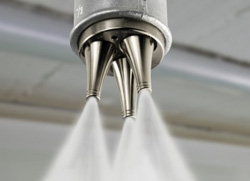Water Mist Puts Out Fires at Low Pressure

Sinorix H2O Jet is meant for industrial environments, including turbines, painting lines, or production equipment. Special nozzles generate a fine mist of tiny water droplets.
The water and the propellant nitrogen are non-hazardous, environmentally friendly, and leave no residues. Sinorix H2O Jet won the Innovation Award in the Fire Fighting category at the Expoprotection trade fair in Paris.
The prerequisites for a fire are oxygen, heat, and fuel. If just one of these factors is eliminated, the fire goes out. Depending on the application, automated fire suppression systems use a variety of agents: water, gases, or a combination of gas and water. Water cools down the flammable material and environment and thereby prevents the fire from spreading rapidly.
And water mist systems have several advantages over sprinklers and foam or gaseous fire-extinguishing systems: The water damage that sprinklers cause to expensive furnishings or equipment is avoided, and no salt residues or surfactants from foam extinguishing agents are left behind. In the past, however, the water mist has been generated by means of high pressure, which makes the installation relatively expensive.
That’s why Siemens Building Technologies has developed a two-phase technology that uses low pressure.
Sinorix H2O Jet was specially developed for the protection of physical assets and their environment. The two-phase technology uses a mixture of water and nitrogen to generate a maximum cooling effect — at a pressure of less than 16 bar with water droplets of 150 to 200 micrometers in diameter. And the smaller the water droplet size, the larger the surface area for heat absorption and for smothering a fire.
When planning a Sinorix H2O Jet system, the Siemens experts calculate the ideal droplet size for the property or equipment to be protected. The system works with two different types of nozzles. One is for protection of the objects; it is a patented nozzle that operates according to the Laval principle and can be used to target and extinguish from a distance of up to eight meters. The other nozzle protects objects as well as their surroundings and controls the fire.
Media Contact
More Information:
http://www.siemens.com/innovationnewsAll latest news from the category: Power and Electrical Engineering
This topic covers issues related to energy generation, conversion, transportation and consumption and how the industry is addressing the challenge of energy efficiency in general.
innovations-report provides in-depth and informative reports and articles on subjects ranging from wind energy, fuel cell technology, solar energy, geothermal energy, petroleum, gas, nuclear engineering, alternative energy and energy efficiency to fusion, hydrogen and superconductor technologies.
Newest articles

Superradiant atoms could push the boundaries of how precisely time can be measured
Superradiant atoms can help us measure time more precisely than ever. In a new study, researchers from the University of Copenhagen present a new method for measuring the time interval,…

Ion thermoelectric conversion devices for near room temperature
The electrode sheet of the thermoelectric device consists of ionic hydrogel, which is sandwiched between the electrodes to form, and the Prussian blue on the electrode undergoes a redox reaction…

Zap Energy achieves 37-million-degree temperatures in a compact device
New publication reports record electron temperatures for a small-scale, sheared-flow-stabilized Z-pinch fusion device. In the nine decades since humans first produced fusion reactions, only a few fusion technologies have demonstrated…





















